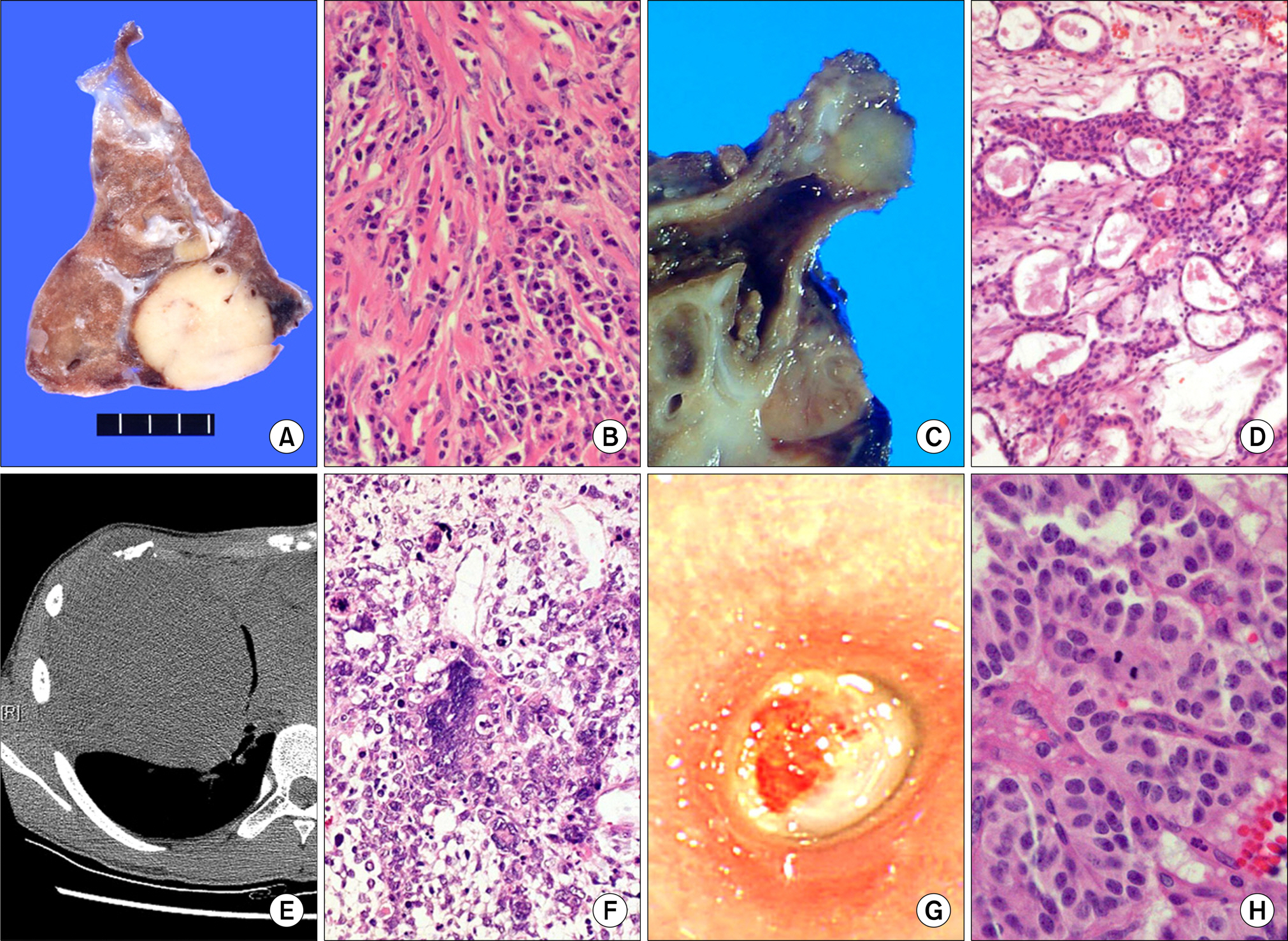J Lung Cancer.
2009 Dec;8(2):103-110. 10.6058/jlc.2009.8.2.103.
Primary Neoplasms of the Lung in Children and Adolescents: 22 Cases from a Single Institute
- Affiliations
-
- 1Department of Pathology, Samsung Medical Center, Sungkyunkwan University School of Medicine, Seoul, Korea. hanjho@skku.edu
- 2Department of Pediatrics, Samsung Medical Center, Sungkyunkwan University School of Medicine, Seoul, Korea.
- 3Department of Thoracic Surgery, Samsung Medical Center, Sungkyunkwan University School of Medicine, Seoul, Korea.
- KMID: 2199970
- DOI: http://doi.org/10.6058/jlc.2009.8.2.103
Abstract
- PURPOSE
Primary lung tumors in children and adolescents are uncommon. We report here on the clinical presentations, the methods of treatment, the results and the outcomes of a series of children with these rare tumors.
MATERIALS AND METHODS
We conducted a retrospective review on all the patients less than 19 years of age with primary lung tumors and who were treated at Samsung Medical Center between 1995 and 2009. Twenty two cases of primary lung tumors were reviewed and the clinical-pathological information concerning the tumor characteristics, the therapy and the follow-up was collected.
RESULTS
The average age of the 10 male patients and 12 female patients was 11.5 years (range: 3 months to 18 years). Of the 22 primary lung tumors, 18.2% (4/22) were benign, 36.4% (8/22) were of borderline malignancy and 45.4% (10/22) were malignant. The pathologic types were inflammatory myofibroblastic tumor (6/22), mucoepidermoid carcinoma (4), pleuropulmonary blastoma (2), adenocarcinoma (1), alveolar soft part sarcoma (1), malignant lymphoma (1), leiomyoma (1), pulmonary leiomyomatous hamartoma (1), congenital pulmonary myofibroblastic tumor (1), Langerhans' cell histiocytosis (1), neurilemmoma (1), sclerosing pneumocytoma (so-called sclerosing hemangioma) (1) and atypical carcinoid tumor (1). After surgery for the benign tumors, no postoperative recurrence was been observed during long-term follow-up. All the patients with the benign tumors were alive with no evidence of disease. For the patients with the tumors of borderline malignancy, one patient experienced recurrence, but there was no death from disease. For the group with malignant tumors, two patients died from untreatable metastatic disease and 8 patients survived their disease on the long-term follow-up.
CONCLUSION
The primary lung tumors during childhood and adolescence had different characteristics compared with their adult counterparts with respect to the incidence and prognosis. These facts must be considered when making the diagnosis and deciding on proper therapy.
Keyword
MeSH Terms
Figure
Reference
-
References
1. Dishop MK, Kuruvilla S. Primary and metastatic lung tumors in the pediatric population: a review and 25-year experience at a large children's hospital. Arch Pathol Lab Med. 2008; 132:1079–1103.
Article2. Cohen MC, Kaschula RO. Primary pulmonary tumors in childhood: a review of 31 years' experience and the literature. Pediatr Pulmonol. 1992; 14:222–232.
Article3. Tischer W, Reddemann H, Herzog P, et al. Experience in surgical treatment of pulmonary and bronchial tumours in childhood. Prog Pediatr Surg. 1987; 21:118–135.
Article4. Welsh JH, Maxson T, Jaksic T, Shahab I, Hicks J. Tracheobronchial mucoepidermoid carcinoma in childhood and adolescence: case report and review of the literature. Int J Pediatr Otorhinolaryngol. 1998; 45:265–273.
Article5. Hancock BJ, Di Lorenzo M, Youssef S, Yazbeck S, Marcotte JE, Collin PP. Childhood primary pulmonary neoplasms. J Pediatr Surg. 1993; 28:1133–1136.
Article6. Neville HL, Hogan AR, Zhuge Y, et al. Incidence and outcomes of malignant pediatric lung neoplasms. J Surg Res. 2009; 156:224–230.
Article7. Hartman GE, Shochat SJ. Primary pulmonary neoplasms of childhood: a review. Ann Thorac Surg. 1983; 36:108–119.
Article8. Weldon CB, Shamberger RC. Pediatric pulmonary tumors: primary and metastatic. Semin Pediatr Surg. 2008; 17:17–29.
Article9. Griffin CA, Hawkins AL, Dvorak C, Henkle C, Ellingham T, Perlman EJ. Recurrent involvement of 2p23 in inflammatory myofibroblastic tumors. Cancer Res. 1999; 59:2776–2780.10. Kantar M, Cetingul N, Veral A, Kansoy S, Ozcan C, Alper H. Rare tumors of the lung in children. Pediatr Hematol Oncol. 2002; 19:421–428.
Article11. Al-Qahtani AR, Di Lorenzo M, Yazbeck S. Endobronchial tumors in children: institutional experience and literature review. J Pediatr Surg. 2003; 38:733–736.
Article12. Baraniya J, Desai S, Kane S, et al. Pleuropulmonary blastoma. Med Pediatr Oncol. 1999; 32:52–56.
Article13. Priest JR, McDermott MB, Bhatia S, Watterson J, Manivel JC, Dehner LP. Pleuropulmonary blastoma: a clinicopathologic study of 50 cases. Cancer. 1997; 80:147–161.14. Parsons SK, Fishman SJ, Hoorntje LE, et al. Aggressive multimodal treatment of pleuropulmonary blastoma. Ann Thorac Surg. 2001; 72:939–942.
Article15. Cadranel J, Naccache J, Wislez M, Mayaud C. Pulmonary malignancies in the immunocompromised patient. Respiration. 1999; 66:289–309.
Article16. Muti G, Cantoni S, Oreste P, et al. Posttransplant lymphoproliferative disorders: improved outcome after clinico-pathologically tailored treatment. Haematologica. 2002; 87:67–77.17. Lack EE, Harris GB, Eraklis AJ, Vawter GF. Primary bronchial tumors in childhood: a clinicopathologic study of six cases. Cancer. 1983; 51:492–497.
Article
- Full Text Links
- Actions
-
Cited
- CITED
-
- Close
- Share
- Similar articles
-
- Dizziness in children and adolescents
- Metabolic syndrome in children and adolescents
- Primary Thyroid Malignancies in Children and Adolescents - A Retrospective Analysis from a Tertiary Cancer Centre in South India
- Surgical Treatment for Multiple Primary Lung Cancer: Report of 2 cases
- Incidence and significance of Multiple Primary Malignant Neoplasms


